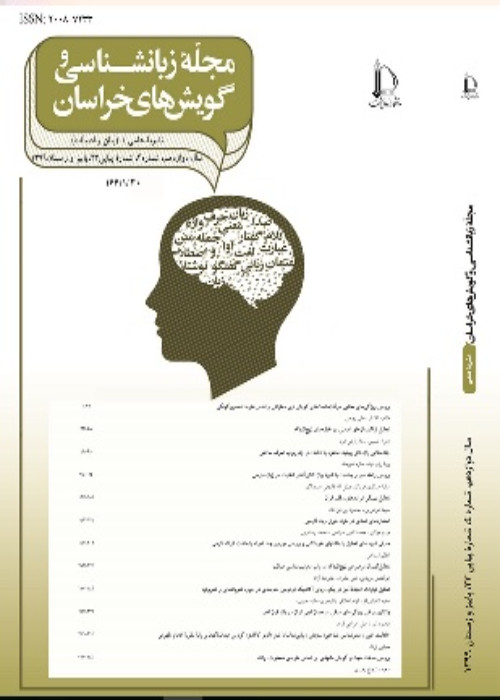Deletion in Farsi
Weakening is the process by which a sound is turned into a sound of lesser degree of stricture or duration. Among different forms of weakening, deletion is the most complete form. Deletion is a phonological process that often occurs in continuous speech. In the sense that whenever the combination of phonemes result in creating an ill-form linguistic unit which is not in agreement with the phonological system of the language, a phonetic unit of the speech chain is deleted to resolve this problem. This process changes the structure of the syllable and creates an acceptable syllabic or lexical pattern coincided with the phonotactics rules and restrictions of a language. The current study aimed to shed light on the process of deletion in Standard Persian language in view of the optimality theory. The following questions were addressed in this research: 1. In what phonetic environment does the deletion process arrive in standard Persian language? 2. Among consonants and vowels, which of them is exposed to the deletion process? 3. What is the category and kind of words in which the deletion process appeared? Review of Literature On the phonological process of deletion, valuable studies have been carried out that can be broadly divided into two categories: standard Persian language researches and studies on different dialects of Persian. In the case of different dialects of Persian, the following studies can be mentioned: Kalbasi, (1991), Shokri, (1995), Borughani, (2004), Alamdari (2005), Korde Zafaranlu Kambuzia and Sha'bani (2007), Kambuziya and Nemati (2007), Sharifi, (2008), Khodabakhshi (2008), Jabarooti (2010), Razmdide (2011), Kazemaini (2011), Miri (2011), Fadaei (2011), Soleimani (2012), Kambuziya, Tajabadi, Esmailimatin, and Khordbin, S.(2016) etc. Furthermore, Lazard (1992), Meshkatodini, (1995), Bijankhan (2006), Kord-e Zafaranlu Kambuziya (2007), Sadeghi (2007), Jam (2009) etc. have studied Standard Persian. A review of the research literature indicates that all studies have focused on only one aspect of this process and so far no comprehensive study has been conducted, especially on the Standard Farsi, which clearly demonstrates the need for the present study.
This descriptive-analytical study describes and explains the phonological process of deletion in the Standard Persian language. For this purpose, in addition to the authors’ intuition and linguistic knowledge, written sources such as books, theses in dialectology and dialect dictionaries have been used to collect the research data. In order to extract the data, in addition to the Standard Farsi, a total of 25 other language varieties were randomly selected. Data extracted from these linguistic varieties were examined only as an evidence to validate the results of this study. Totally, 881 samples from Standard Farsi and 200 samples from different dialects were extracted. Then these data were examined in terms of the type of linguistic unit removed, the context and also the structure and lexical category of the word in which the deletion process occurs. Furthermore, the percentage of units affected by the process was calculated. Finally, these data were analyzed within the framework of standard optimality theory (Prince & Smolensky, 1993).
In this section, we examine the different types of deletion in the Standard Persian language in terms of the deleted unite, the position and context in which the deletion take place. A close look at the data shows that the deleted unit can be consonant, vowel, consonant-vowel sequence, or vowel-consonant sequence. Depending on the number of deletions in each datum, it can be categorized into single deleted item group or multiple deleted items group. In items of the second group, two consonants or one consonant with a consonant-vowel sequence or vowel-consonant sequence, are deleted. It is worth noting that the deletion of only one consonant is the most frequent ones; however the deletion of two consonants is more varied than other types of deletion. Among all kind of consonants, stops make a greater contribution to the deletion process and fricatives rank second. In addition, among stop consonants, the share of coronal consonant and among fricatives, the contribution of glottals is greater than others. In multiple deleted items group, deletion of stop-stop consonants accounts for the most. On the other hand, examination of data in which only vowel deletion has occurred (51 cases) indicates that out of the six Persian vowels, only three short vowels (a, e, o) are deleted in a single word. Of the 47 cases of vowel-consonant deletion, 83% of deleted vowels were short ones. In addition, out of the 38 consonant-vowel deletions, only 18% of the deleted vowels were long vowels. Regarding the relationship between deletion and number of word syllables, it can be said that among the one-to-five syllable words, the three syllable words have the highest and the two syllable words have the least tendency toward the deletion process. With regard to the relation of deletion to lexical type and category, it seems that words with the lexical category of noun and derivative structure have the highest share. In terms of the position in which deletion occurs (initial, middle, final position of syllable or word, syllables boundary, the boundary of two morphemes), it can be said that in Standard Persian there is only a middle and ending deletion, and the final deletion is much more than the middle deletion. Analysis of the results demonstrated that consonants underwent the deletion process more than vowels. Meanwhile stop consonants and short vowels (a, e, o) were ranked first in deletion process as compared with others. The findings also indicated that derivations, nouns, and two or three syllable words were more likely to be deleted. Furthermore, last syllable of the words tends to be the best place for applying the deletion process.
It can be said that when some of the universal principles like Sonority Sequencing Principle (SSP) and Syllable Contact Law (SCL) are violated, a series of phonological processes, including the deletion process, are used to modify the existing structure. In addition, the presence of heavy syllables or an abundance of light syllables creates a kind of asymmetry in words. This type of sequence is both productively and audibly problematic. In these cases, phonological processes, such as deletion, operate to bring the desired structure as close as possible to the optimal syllable of the language studied.
- حق عضویت دریافتی صرف حمایت از نشریات عضو و نگهداری، تکمیل و توسعه مگیران میشود.
- پرداخت حق اشتراک و دانلود مقالات اجازه بازنشر آن در سایر رسانههای چاپی و دیجیتال را به کاربر نمیدهد.



